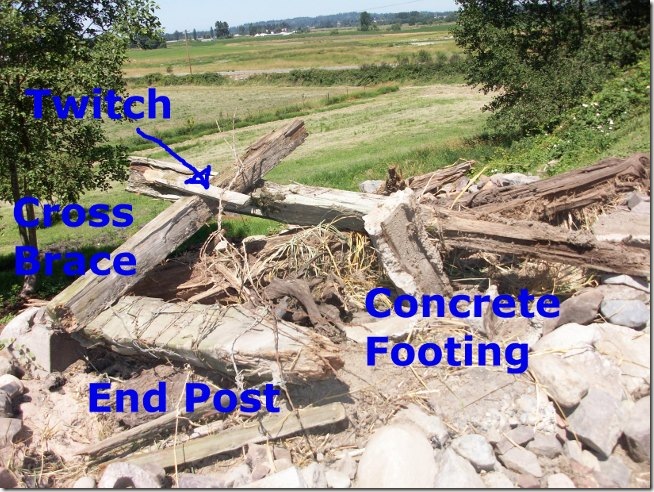This is a very, very old fencing H-brace that I just removed from our pasture. I would venture a guess that it is part of the original farm homestead, and was probably installed before 1910. It is interesting to see that people in our region are still building these the same way, and to see where this one failed as it aged. Most of the old fencing from this place is gone, but there are a few stretches here and there that remain, half-consumed by nature.
This section had three-strand barbed wire strung on it, which had long ago become slack. The brace at the other end of the field was gone, so I had to yard out all of the tangled barbed wire from the grass, using the tractor’s strength to dislodge it.
You can see the end post, with multiple winds of wire going around it. It had broken off at the level of the soil, from rot. The cross-beam was still there, decayed, but not as much as the posts in the ground. I couldn’t tell how the cross-beam was attached, I assume just wedged into notches, with no pins, so it had fallen out once the tension was lost.
The other brace post came out of the hole with its concrete footer still clinging to the wood. This broke in two when I dumped it in the fire pit, it didn’t have very thick walls. The diagonal tension wire was still there, still with its twitch stick twisted up in the middle.
All of the above-ground wood was somewhat decayed, just from years of sun and rain exposure- it had that lightweight, near-balsa-wood feel that wood gets from years of weathering. But, the main failure point was the parts in the ground- not surprising for our soggy climate. The wire and metal T-posts along the fence line were still in good structural shape (though the T-posts were all bent from being run over), so I’m assuming those were more modern. But they were still probably at least 40 years old, as I don’t think livestock has been run in that field for many decades.
The wood posts looked like very old, rough-cut, untreated fir or cedar (I couldn’t tell which); both of which were available in abundance at the time this farm was homesteaded. But, oddly, when we burned them in our campfire pit, black tar started oozing out of them. I’m guessing this was leftover from some age-old method of treating wood posts, that pre-dates modern methods?
So, it would seem that this clue from the past tells us what we need to worry about most when attempting to install fencing with the greatest longevity in our climate: protecting the in-ground wood from rot for as long as possible.
